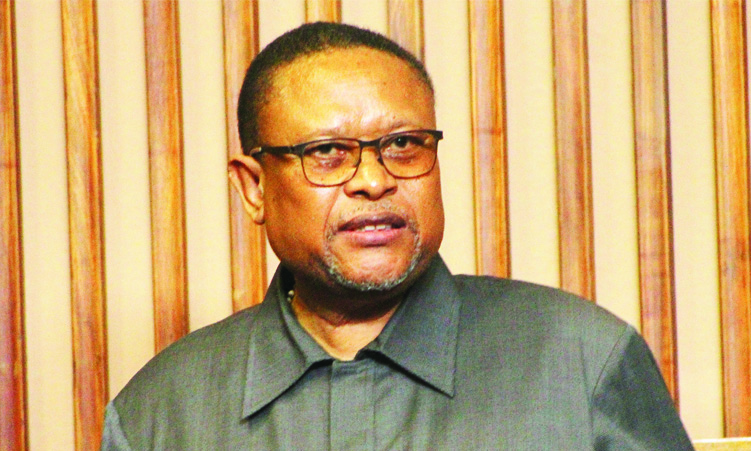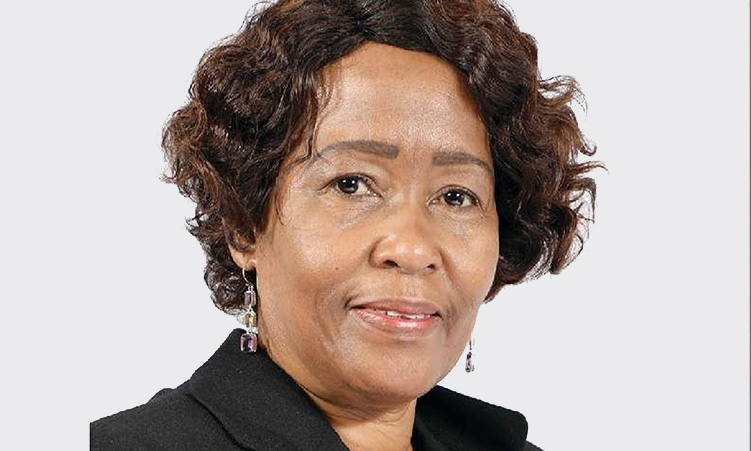WATER utility NamWater yesterday warned consumers that an impending power shortage could also affect the supply of water around the country.
NamWater Chief Executive Officer Vaino Shivute told the business community in Windhoek that his company was in talks with NamPower over possible power outages in the wake of an energy crisis in South Africa, and would be issuing “cautionary notes” to warn customers about where these outages would affect the supply of water too. The business community was called together by NamPower and the Namibia Chamber of Commerce and Industry yesterday to inform them of the current power situation and prepare them for the effects it could have on them, should NamPower be forced to introduce load-shedding measures.Shivute said many people were unaware that NamWater required power to pump water across vast areas of the country.NamPower Managing Director Leake Hangala yesterday said that load shedding was the last resort for the utility and that it was doing all it could to up local power generation to meet domestic demands and reduce dependency on imports from South Africa.”When South Africa coughs, we don’t get a cold, we get bird flu,” said Hangala.The Western Cape has been particularly hard hit by a breakdown at one of the two units of the Koeberg nuclear power station in Cape Town since January, and power cuts for long periods of the day have been causing chaos in business, households and traffic.Hangala told business people that NamPower planned to invest N$8 billion over the next four years to strengthen Namibia’s capacity to import power from countries other than South Africa and until it can start making long-term projects such as Kudu Gas and Baynes Hydropower a reality.He said the power utility wanted to avert a situation where power shortages would cripple business and the development of the country.”NamPower is working very hard so that if we can’t eliminate the problem, we at least can minimise the effect,” said Hangala about the company’s plans to plug the gap between demand and supply.By 2007, the demand for power in the southern African region (50 000 megawatts) is expected to exceed supply.Namibia is already operating on a deficit, being able to generate only 384 megawatts when all its stations are operating at full capacity, compared to a peak demand of 500 megawatts.Hangala said Namibia had to be thankful for having been able to import electricity from South African utility Eskom over the last ten years, as it had allowed NamPower to keep the price of electricity low and had ensured reliable and quality power supply in Namibia.But it has also had the effect of no investment in additional power plants for more than a decade.”It is clear that if Koeberg doesn’t come on, we will be in problems.The problem will be exacerbated if both units don’t come on stream,” said Hangala.With unit one still to be repaired by the time the second unit is set to undergo compulsory maintenance next month, Eskom is hard pressed to get the power station running at full capacity before the winter peak period begins.Big businesses, such as mines, have been asked to identify periods when they are able to shut down electricity supply to save the available resources, while ordinary consumers are urged to use their supply prudently.One of the issues raised by businesses about the eventuality of a power crunch was whether Government would be prepared to scrap duties on fuel, should they require large quantities to generate their own power.The Director of Energy could not immediately give an answer.Advocates for renewable energy accused NamPower of being adverse to exploring its potential for the country as a quicker, cheaper, long-term option to generate small amounts of power to support bigger stations when they are not able to run at full capacity.Hangala said the commercial sector had to be encouraged to make more use of solar energy.But NamPower said tapping into wind power in the South had not yet proven to be a viable option.The main reasons for this are that alternative power sources would be needed when there is no wind, and the high cost of maintaining infrastructure in a hostile environment.NamPower’s Chief Technical Advisor, Reiner Jagau, defended the company’s position on renewable energy, saying while they supported the idea, they could not be expected to drive the process and at this time it was best left to the Ministry of Mines and Energy.The company said, however, that it did welcome suggestions as to how this form of energy could be integrated into the current system.”We must be focused as a company, otherwise we discuss all the projects and we have nothing after five years,” said Hangala.”The idea is not to be defensive at all about renewables, but it must make economic sense, it must be viable, it must also be realistic, professional and scientific.”NamPower informed the business fraternity that it would start laying a transmission line from Zambia in June, which would improve power supply to Caprivi and eventually allow for power from Zambia to reach Windhoek in the next two years.Another transmission line will be laid from Zimbabwe to increase interconnectivity to Namibia.Hangala said connecting Namibia to other countries via a transmission line was cheaper and quicker than building another power station and would tide Namibia over the crunch period until it could start building power stations by 2010.The business community was called together by NamPower and the Namibia Chamber of Commerce and Industry yesterday to inform them of the current power situation and prepare them for the effects it could have on them, should NamPower be forced to introduce load-shedding measures.Shivute said many people were unaware that NamWater required power to pump water across vast areas of the country.NamPower Managing Director Leake Hangala yesterday said that load shedding was the last resort for the utility and that it was doing all it could to up local power generation to meet domestic demands and reduce dependency on imports from South Africa. “When South Africa coughs, we don’t get a cold, we get bird flu,” said Hangala.The Western Cape has been particularly hard hit by a breakdown at one of the two units of the Koeberg nuclear power station in Cape Town since January, and power cuts for long periods of the day have been causing chaos in business, households and traffic.Hangala told business people that NamPower planned to invest N$8 billion over the next four years to strengthen Namibia’s capacity to import power from countries other than South Africa and until it can start making long-term projects such as Kudu Gas and Baynes Hydropower a reality.He said the power utility wanted to avert a situation where power shortages would cripple business and the development of the country.”NamPower is working very hard so that if we can’t eliminate the problem, we at least can minimise the effect,” said Hangala about the company’s plans to plug the gap between demand and supply.By 2007, the demand for power in the southern African region (50 000 megawatts) is expected to exceed supply.Namibia is already operating on a deficit, being able to generate only 384 megawatts when all its stations are operating at full capacity, compared to a peak demand of 500 megawatts.Hangala said Namibia had to be thankful for having been able to import electricity from South African utility Eskom over the last ten years, as it had allowed NamPower to keep the price of electricity low and had ensured reliable and quality power supply in Namibia.But it has also had the effect of no investment in additional power plants for more than a decade.”It is clear that if Koeberg doesn’t come on, we will be in problems.The problem will be exacerbated if both units don’t come on stream,” said Hangala.With unit one still to be repaired by the time the second unit is set to undergo compulsory maintenance next month, Eskom is hard pressed to get the power station running at full capacity before the winter peak period begins.Big businesses, such as mines, have been asked to identify periods when they are able to shut down electricity supply to save the available resources, while ordinary consumers are urged to use their supply prudently.One of the issues raised by businesses about the eventuality of a power crunch was whether Government would be prepared to scrap duties on fuel, should they require large quantities to generate their own power.The Director of Energy could not immediately give an answer.Advocates for renewable energy accused NamPower of being adverse to exploring its potential for the country as a quicker, cheaper, long-term option to generate small amounts of power to support bigger stations when they are not able to run at full capacity.Hangala said the commercial sector had to be encouraged to make more use of solar energy.But NamPower said tapping into wind power in the South had not yet proven to be a viable option.The main reasons for this are that alternative power sources would be needed when there is no wind, and the high cost of maintaining infrastructure in a hostile environment.NamPower’s Chief Technical Advisor, Reiner Jagau, defended the company’s position on renewable energy, saying while they supported the idea, they could not be expected to drive the process and at this time it was best left to the Ministry of Mines and Energy.The company said, however, that it did welcome suggestions as to how this form of energy could be integrated into the current system.”We must be focused as a company, otherwise we discuss all the projects and we have nothing after five years,” said Hangala.”The idea is not to be defensive at all about renewables, but it must make economic sense, it must be viable, it must also be realistic, professional and scientific.”NamPower informed the business fraternity that it would start laying a transmission line from Zambia in June, which would improve power supply to Caprivi and eventually allow for power from Zambia to reach Windhoek in the next two years.Another transmission line will be laid from Zimbabwe to increase interconnectivity to Namibia.Hangala said connecting Namibia to other countries via a transmission line was cheaper and quicker than building another power station and would tide Namibia over the crunch period until it could start building power stations by 2010.
Stay informed with The Namibian – your source for credible journalism. Get in-depth reporting and opinions for
only N$85 a month. Invest in journalism, invest in democracy –
Subscribe Now!










